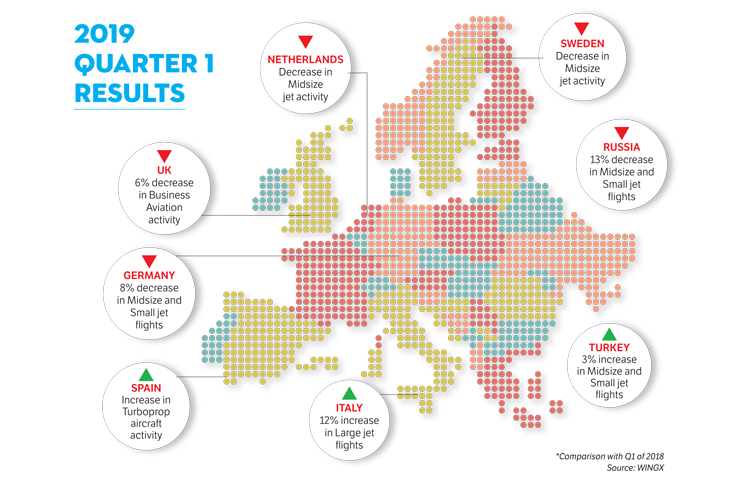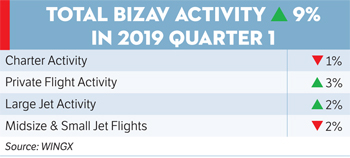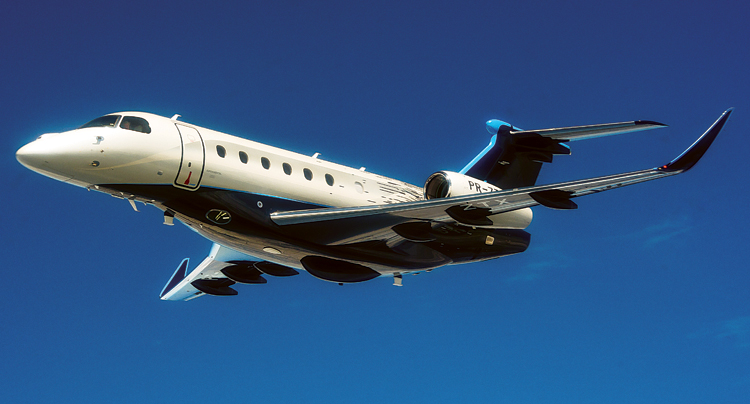INDIAN ARMED FORCES CHIEFS ON
OUR RELENTLESS AND FOCUSED PUBLISHING EFFORTS

SP Guide Publications puts forth a well compiled articulation of issues, pursuits and accomplishments of the Indian Army, over the years

I am confident that SP Guide Publications would continue to inform, inspire and influence.

My compliments to SP Guide Publications for informative and credible reportage on contemporary aerospace issues over the past six decades.
Europe BizAv Industry Airborne Despite Strong Headwinds
Online marketing for younger customers holds promise amidst shifting trend from ownership to rentals, as this segment records 9 per cent growth in the First Quarter of 2019 compared to the corresponding period in 2018

Following fluctuations during most of the 2018, Europe’s fragile economy was off to a more promising first quarter in 2019. Markets had been bogged down by a decline in the Euro zone, with countries not emerging from recession, concerns about the US-China trade war and the uncertainty around Britain’s exit from the European Union.
Driven by domestic demand, the economic activity showed signs of recovery in the first half of 2018 but at a slower-than-expected pace, specifically in Western Europe, according to figures presented by the IMF. However, the economy belied the promise of the First Quarter, eventually slowing down in the rest of the year. Hampered by various trends, the environment became less supportive for growth. The drop in external demand along with higher oil prices dampened the incomes. Commodity prices increased 7 per cent since the spring of 2018, while oil prices climbed to around $80 a barrel in September 2018. As a result, real disposable incomes fell, on an average, by 0.5 percentage points of GDP in most of Europe.


A bright spot, the IMF noted, was buoyance in Europe’s manufacturing sector, which enjoyed one of the best periods of expansion over the last two decades. But against the background of a maturing business cycle, production capacity constraints and labour shortages arrested growth, especially in emerging Europe. The gains were shortlived due to the constraining factors.
Germany, the biggest driver for the European economy, has been sluggish this year, adversely affecting the overall situation. According to the data released by the German statistical office Destatis, the manufacturing sector figure for March 2019 had fallen to an 80-month low (of 44.1). The composite future output PMI (Purchasing Managers’ Index) also fell to a more than a four-year low. The economy moved like a yoyo in comparison to the corresponding period last year. In fact, the Euro zone saw the greatest contraction of its manufacturing sector for nearly six years in March 2019 with its PMI at 47.5, down from 49.3 in February this year, and this trend continued into the Second Quarter as well.
Online booking platforms with faster response times, more transparency and better pricing are facilitating new ways of further expanding customers’ freedom of choice in this evolving industry
But the Business Aviation (or BizAv) segment is one sector which has withstood the vicissitudes and kept itself airborne. This segment has had a stellar contribution to the European economy since the first Business Aviation aircraft took off in 1927. According to European Business Aviation Association (EBAA) figures, BizAv contributes a total of 1,92,000 jobs to the European economy directly, with an additional 1,82,000 estimated to be generated indirectly.
Last year EBAA’s former CEO, Brandon Mitchener said that the segment was showing promising signs of vigour after a few years of flat figures. However, 2018 didn’t see expected levels of business. Germany, UK, Switzerland, Italy and France, are the key locations where business aircraft operate, accounting for 57 per cent of all direct, indirect and induced jobs in business aircraft operation. At the regional level, major centres for Business Aviation activities are Paris, Greater London and Geneva.
SLUGGISH BUSINESS JET ACTIVITY
Today the European Business Aviation industry consists of a mixture of charter, corporate, private and fractional operations. Business Aviation is now beyond privately-owned or chartered planes. It also covers government flights on government-owned or wholly chartered planes; flights for cargo, packaging or spare part shipments; charter helicopters and flights for the medical sector.
According to latest data from WingX, 66,736 business aviation departures were recorded in Europe in March 2019, which was a strong increase over February 2019, but represented a modest 0.7 per cent hike over the corresponding figure last year. A significant increase in piston engine traffic offset the decline in business jet and turboprop traffic with total activity in the First Quarter of 2019 going up by 0.6 per cent versus that of 2018.

April 2019 saw modest growth in top market France, slightly declining activity in Switzerland and UK, a big drop in Germany but large gains in Spain. While the decline in Germany came in Small and Midsize jets, all the gains in Spain came from turboprop aircraft. Besides Germany, the biggest decline in April 2019 was in Sweden and the Netherlands. Turkish activity was also up 3 per cent this month, but there was a deficit of 12 per cent when compared to last year. First Quarter growth was strongest in Spain, with total business aviation activity up 9 per cent compared to the same period last year.
Charter activity dropped 1 per cent in April, reinforcing a much weaker trend so far this year compared to last year. Conversely, private flight activity increased 3 per cent, extending a stronger trend compared to the last two years.
Interesting Seminars at Upcoming EBACE 2019
| Sustainable Alternative Jet Fuel: Properties & Prospects | May 21 14:00 -15:00 Innovation Zone | How widely can SAJF be used within the business aviation sector currently as well as in times to come? Panelists from Gulfstream, Bombardier and Av Fuels |
| Future of Flying: Electric Propulsion and Business Aviation | May 21 15:30 -16:30 Innovation Zone | Is aircraft electrification the next chapter in business aviation? Panelists from European Aviation Safety Agency, General Aviation Manufacturers Association, Starburst Aerospace Accelerator |
| e-VTOL: An Urban Mobility Solution | May 22 13:00 -14:00 Innovation Zone | Why eVTOL promises to be a disruptive technology, who the key players are, and the potential timeline for launch? Panelists from Airbus, Volocopter and jetAVIVA |
| Lexi, Book Me a Jet: Artificial Intelligence and Business Aviation | May 22 15:00 -16:00 Innovation Zone | Can Artificial Intelligence redefine the way Aerospace businesses work? Panelists from Appaero, GE Aviation, GlobeAir, and Collins Aerospace |
| Tomorrow’s Landscape: A Look at Disruptive Modes of Transport | May 22 16:30 -17:00 Innovation Zone | How will hyperloop, urban air taxis, supersonic flight and sub-orbital travel redefine business aviation? Presenter: Dr Anita Sengupta, rocket scientist, aerospace engineer and chief product officer Airspace Experience Technologies |
Textron aircraft flew 4 per cent less in April; Gulfstream jet activity went flat, whereas Bombardier, Dassault and Embraer jet flights were up year-onyear. Strong growth was also observed in Bombardier Charter movements, and for Dassault in private flights.
BIZAV STILL THE PREFERRED CHOICE
Termed as the “Symbol of European excellence” by EBAA, Business Aviation is a dynamic sector which fosters technical innovation and environmental stewardship across the full value chain, from manufacturers to operators leading to productivity gains, while also connecting communities in remote places, and boosting their economic growth in the process. Business aviation’s unmatched value proposition is this: Meeting needs like no other transport option can by helping users gain direct access to destinations while achieving huge time savings, flexibility and full control over their schedules—even if their itineraries combine multiple and remote destinations.
AIRSPACE STRUGGLE
The need for closely tailored, flexible, point-to-point air transportation for governments, businesses and local communities in the most time-efficient way possible that business aviation provides has been demonstrated in Europe. The use of new technologies such as electrification, VTOL (Vertical Take-Off and Landing), block chain, artificial intelligence, and alternative fuels are also igniting the pace of innovation in aviation. However, these muchneeded improvements and technological advances will only be made possible if the European Union is able to provide adequate infrastructure for business aviation operators in Europe. In particular, access to airports and airspace along with the lack of pilots in the dense flying environment, remain major hurdles for the sector. European business aviation also calls for an inclusive European Aviation Framework to enable improved connectivity, efficiency, European competitiveness and regional cohesion across the continent.
MILLENNIALS AND BIZAV’S DIGITIZATION
For millennials, however, BizAv also means freedom. EBAA observed that 62 per cent of millennials believe that the main benefit of business aviation is its ability to take people where they need and when they need, on demand. The future, then, seems to be bright for BizAv with transformations happening in the manner of flying through innovative & sustainable technologies. 59 per cent of millennials even believe that new forms of air transport will drastically change lives and see BizAv as an attractive career choice, creating job growth in research, innovation & engineering.

A lot of this interest has also been generated due to the online brokerage system that is quite active in Europe. With the charter market in Europe not being as consolidated, the brokers have particularly leveraged online sales platforms. On the online marketplaces, light jet charters have flourished, especially with infrequent users of business aviation, who are on the fence about stepping up to fractional or private ownership.
Online booking platforms with faster response times, more transparency and better pricing are facilitating new ways of further expanding customers’ freedom of choice in this evolving industry.
According to EBAA, business aviation contributes a total of 1,92,000 jobs to the European economy directly, with an additional 1,82,000 estimated to be generated indirectly
EBAA member company Stratajet correlated the growth in its customer base to online bookings. Embraer’s Michael Amalfitano said, “We are reaching out to new types of customers, one-third of whom are first-time private jet users, and many of whom are in the 25-34 age segment, comprising a tech-savvy new audience of fliers, new technologies that enhance safety and access to smaller airports. Because millennials, the future customers of the industry, have a very different approach to how they buy and use things to previous generations since they use the device in their palm to buy everything they need and then share it with everyone they know. Does that bode well for the much-needed digitization of the business aviation industry? Only time can tell.”
OPTIMISM IN THE AIR
Though the majority of the total business aviation flights in Europe, 63 per cent to be precise, are concentrated in five countries – France, United Kingdom, Germany, Italy and Switzerland, the smaller markets have also finally started warming up.
The enhancing online brokerage and the growing awareness have increased hope for the business aviation industry in Europe despite the fluctuating economy. With this shift from owning to renting, consumer preferences have changed as it allows them to enjoy the benefits of private jets without worrying about maintenance costs and procedures. The swift advent of social media has been another reason as it has made it easier than ever to reach out to the masses through unified marketing channels, while intuitive applications and engaging content allows for an unprecedented scale of marketing.
Amid fluctuating economy and speculative forecasts, the business aviators are gearing up for the upcoming EBACE 2019 with enthusiasm. To be held from May 21st in Geneva for three days, the European Business Aviation Convention & Exhibition (EBACE) is jointly hosted each year by EBAA, the leading association for Business Aviation in Europe, and the National Business Aviation Association (NBAA), the leading voice for the Business Aviation industry in the United States.





